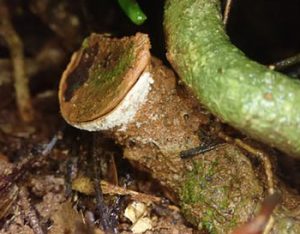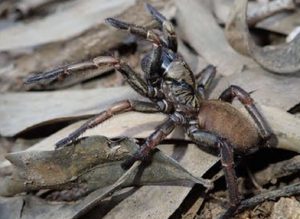Australia now has four new species of trapdoor spiders to keep an eye out for, and a Griffith University PhD candidate formed a vital part of the Queensland team that made the discoveries.

One of the intricate burrows from the new trapdoor species. Credit: Jeremy Wilson
Jeremy Wilson, who described the spiders under the supervision of Queensland Museum arachnologists Dr Robert Raven and Dr Michael Rix, said the new species were found at sites between Montville and Maleny on the Sunshine Coast, as well as to the north in Gympie.
Trapdoor spiders are known for the unique way they build their burrow entrances – using soil to construct little towers. The Latin word ‘turris’ means turret or tower, hence the species have been dubbed the ‘turrificus’ group.
“Trapdoor spider belong to a group called the Mygalomorphae – spiders in this group don’t make aerial webs like people see in their garden; instead they construct deep, silk-lined burrows which sometimes have a hinged door at the top,” he said.
“To identify a trapdoor spider species, you usually have to dig the spider up and look at it carefully under a microscope, which can involve killing the spider, but what’s amazing about these new species is is that all four can be identified based on the appearance of their burrow.”
The team found that the burrows of these new trapdoor species were unusual, in that they were more ornate – decorated with patterns and shapes – than those of their fellow trapdoor species.
“There must be an evolutionary reason why these spiders construct these peculiar burrows; we don’t know what that is yet, but naming each species is the first step to learning about their mysterious lives,” he said.

Arbanitis longpipes, a species of trapdoor spider in Eastern Australia. Credit: Jeremy Wilson
The four new trapdoor spider species were all found within a very small range in rain forest patches surrounded by land that had been cleared for housing or agriculture.
“It’s amazing that strange new species like these occur within one of Australia’s most developed regions, and it just goes to show the conservation importance of even small patches of remnant forest,” he said.
“There are really interesting animals in those patches that we still don’t know about, and for some of these species, the small rain forest patches that many of us drive past each day are their only home.”
Queensland Museum arachnologist and co-author Dr Robert Raven said the discovery of the four new species came as a surprise, given the intricate constructions of the burrows.
“When we made the connection between the unique burrow entrances and the trapdoor spiders, it was an amazing discovery and something I have not seen in my career studying spiders until now,” he said.
“This is a remarkable discovery by Jeremy and will go a long way to helping identify these specific species of trapdoor spiders in the future.”
